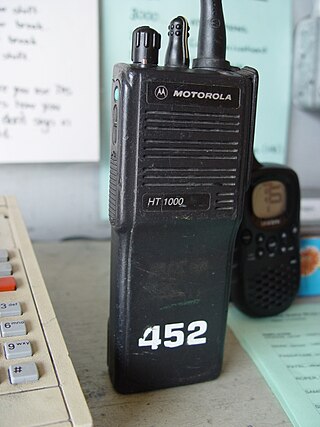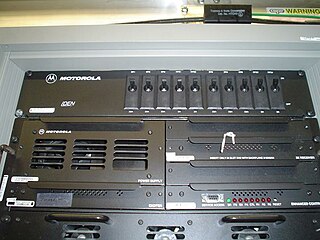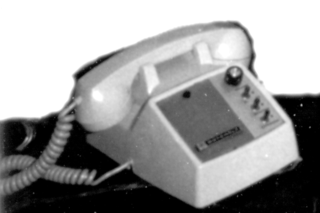
Very low frequency or VLF is the ITU designation for radio frequencies (RF) in the range of 3–30 kHz, corresponding to wavelengths from 100 to 10 km, respectively. The band is also known as the myriameter band or myriameter wave as the wavelengths range from one to ten myriameters. Due to its limited bandwidth, audio (voice) transmission is highly impractical in this band, and therefore only low data rate coded signals are used. The VLF band is used for a few radio navigation services, government time radio stations and for secure military communication. Since VLF waves can penetrate at least 40 meters (131 ft) into saltwater, they are used for military communication with submarines.

A radiotelephone, abbreviated RT, is a radio communication system for conducting a conversation; radiotelephony means telephony by radio. It is in contrast to radiotelegraphy, which is radio transmission of telegrams (messages), or television, transmission of moving pictures and sound. The term is related to radio broadcasting, which transmit audio one way to listeners. Radiotelephony refers specifically to two-way radio systems for bidirectional person-to-person voice communication between separated users, such as CB radio or marine radio. In spite of the name, radiotelephony systems are not necessarily connected to or have anything to do with the telephone network, and in some radio services, including GMRS, interconnection is prohibited.

Power-line communication (PLC) is the carrying of data on a conductor that is also used simultaneously for AC electric power transmission or electric power distribution to consumers. The line that does so is known as a power-line carrier.
In telecommunications, Continuous Tone-Coded Squelch System or CTCSS is one type of in-band signaling that is used to reduce the annoyance of listening to other users on a shared two-way radio communication channel. It is sometimes referred to as tone squelch or PL for Private Line, a trademark of Motorola. It does this by adding a low frequency audio tone to the voice. Where more than one group of users is on the same radio frequency, CTCSS circuitry mutes those users who are using a different CTCSS tone or no CTCSS.

A walkie-talkie, more formally known as a handheld transceiver (HT), is a hand-held, portable, two-way radio transceiver. Its development during the Second World War has been variously credited to Donald Hings, radio engineer Alfred J. Gross, Henryk Magnuski and engineering teams at Motorola. First used for infantry, similar designs were created for field artillery and tank units, and after the war, walkie-talkies spread to public safety and eventually commercial and jobsite work.

Professional mobile radio are person-to-person two-way radio voice communications systems which use portable, mobile, base station, and dispatch console radios. PMR systems are based on such standards as MPT-1327, TETRA, APCO 25, and DMR which are designed for dedicated use by specific organizations, or standards such as NXDN intended for general commercial use. These systems are used by police, fire, ambulance, and emergency services, and by commercial firms such as taxis and delivery services. Most systems are half-duplex, in which multiple radios share a common radio channel, and only one can transmit at a time. Transceivers are normally in receive mode, the user presses a push-to-talk button on his microphone when he wants to talk, which turns on his transmitter and turns off his receiver. They use channels in the VHF and UHF bands, giving them a limited range, usually 3 to 20 miles depending on terrain. Output power is typically limited to 4 watts. Repeaters installed on tall buildings, hills or mountain peaks are used to increase the range of systems.

Project 25 is a suite of standards for interoperable digital two-way radio products. P25 was developed by public safety professionals in North America and has gained acceptance for public safety, security, public service, and commercial applications worldwide. P25 radios are a direct replacement for analog UHF radios, adding the ability to transfer data as well as voice for more natural implementations of encryption and text messaging. P25 radios are commonly implemented by dispatch organizations, such as police, fire, ambulance and emergency rescue service, using vehicle-mounted radios combined with repeaters and handheld walkie-talkie use.
In a digitally modulated signal or a line code, symbol rate, modulation rate or baud rate is the number of symbol changes, waveform changes, or signaling events across the transmission medium per unit of time. The symbol rate is measured in baud (Bd) or symbols per second. In the case of a line code, the symbol rate is the pulse rate in pulses per second. Each symbol can represent or convey one or several bits of data. The symbol rate is related to the gross bit rate, expressed in bits per second.
A land mobile radio system (LMRS) is a person-to-person voice communication system consisting of two-way radio transceivers which can be stationary, mobile, or portable.

An amateur radio repeater is an electronic device that receives a weak or low-level amateur radio signal and retransmits it at a higher level or higher power, so that the signal can cover longer distances without degradation. Many repeaters are located on hilltops or on tall buildings as the higher location increases their coverage area, sometimes referred to as the radio horizon, or "footprint". Amateur radio repeaters are similar in concept to those used by public safety entities, businesses, government, military, and more. Amateur radio repeaters may even use commercially packaged repeater systems that have been adjusted to operate within amateur radio frequency bands, but more often amateur repeaters are assembled from receivers, transmitters, controllers, power supplies, antennas, and other components, from various sources.

A radio repeater is a combination of a radio receiver and a radio transmitter that receives a signal and retransmits it, so that two-way radio signals can cover longer distances. A repeater sited at a high elevation can allow two mobile stations, otherwise out of line-of-sight propagation range of each other, to communicate. Repeaters are found in professional, commercial, and government mobile radio systems and also in amateur radio.
Selcall is a type of squelch protocol used in radio communications systems, in which transmissions include a brief burst of sequential audio tones. Receivers that are set to respond to the transmitted tone sequence will open their squelch, while others will remain muted.
GE Marc V is a historic U.S. format or protocol of trunked, two-way radio introduced by General Electric Mobile Radio in the early 1980s. This equipment was also sold in Australia. The product name looks and sounds similar to GE-Mark V, a turbine controller made by General Electric. GE developed the EDACS radio system based on its success with Marc V.
In telecommunications, falsing is a signaling error condition when a signal decoder detects a valid input although the implied protocol function was not intended. This is also known as a false decode. Other forms are referred to as talk-off.

Mobile radio or mobiles refer to wireless communications systems and devices which are based on radio frequencies, and where the path of communications is movable on either end. There are a variety of views about what constitutes mobile equipment. For US licensing purposes, mobiles may include hand-carried,, equipment. An obsolete term is radiophone.
In a conventional, analog two-way radio system, a standard radio has noise squelch or carrier squelch, which allows a radio to receive all transmissions. Selective calling is used to address a subset of all two-way radios on a single radio frequency channel. Where more than one user is on the same channel, selective calling can address a subset of all receivers or can direct a call to a single radio. Selective calling features fit into two major categories—individual calling and group calling. Individual calls generally have longer time-constants: it takes more air-time to call an individual radio unit than to call a large group of radios.
MDC, also known as Stat-Alert, MDC-1200 and MDC-600, is a Motorola two-way radio low-speed data system using audio frequency shift keying, (AFSK). MDC-600 uses a 600 baud data rate. MDC-1200 uses a 1,200 baud data rate. Systems employ either one of the two baud rates. Mark and space tones are 1,200 Hz and 1,800 Hz. The data are sent in bursts over the radio system's voice channel.

Remote controls are used any time a two-way radio base station is located away from the desk or office where communication originates. For example, a dispatch center for taxicabs may have an office downtown but have a base station on a distant mountain top. A Tone remote, also known as an EIA Tone remote, is a signaling system used to operate a two-way radio base station by some form of remote control.
An international distress frequency is a radio frequency that is designated for emergency communication by international agreement.
The Yaesu FT-2900R is a VHF 2M FM mobile amateur radio transceiver. It is no longer in production and has been replaced by the FT-2980.










